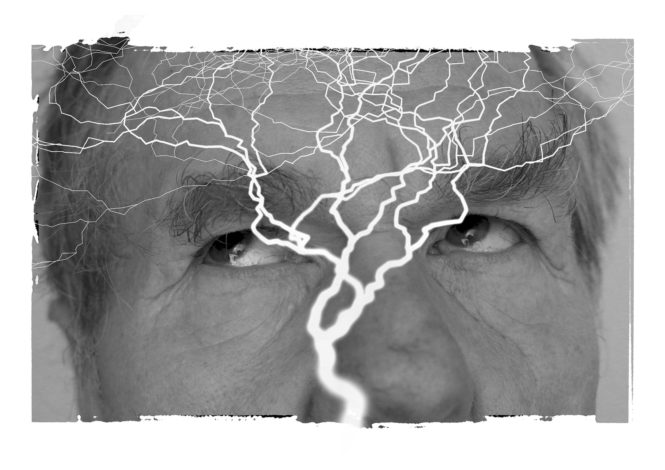Introduction
Most headaches are benign and do not require a specific workup. Here are the ominous ones that require a specific workup and management.
From the Patient History
- Sudden, severe, and maximal at onset, especially in an older patient without a prior history of headaches → subarachnoid hemorrhage → get a head CT without contrast → CT angiogram or cerebral angiogram.
- Systemic symptoms
- Weight loss → cancer, infection
- Fevers, chills → meningitis, encephalitis
- New onset headache in an older adult (e.g., > age 55) →suspect giant cell arteritis (“temporal arteritis”)
- Local signs and symptoms
- Unilateral vision loss
- Jaw claudication: pain on chewing (secondary to masseter muscle ischemia)
- Non-pulsatile, tender or indurated temporal artery
- Systemic signs and symptoms
- fever, weight loss, proximal muscle aches
- concomitant polymyalgia rheumatica is common (↑ ESR, ↑ WBC, ↓ Hb/Hct)
- Treat immediately with high dose steroids, followed by a biopsy of the temporal artery.
- Local signs and symptoms
- Progressively worsening headache or vomiting (in terms of severity and/or frequency) → expanding intracranial lesion with mass effect (e.g., hematoma or tumor), increasing intracranial pressure.
- Postural headaches
- Worse when in upright position, relieved with recumbency (orthostatic headache) → intracranial hypotension.
- Worse with bending over or prolonged recumbency (e.g., early morning headache) → intracranial hypertension (from tumor or idiopathic) → image brain.
- Also worse with coughing, sneezing and Valsalva.
- With acute, unilateral retro-orbital headache or neck pain → cervical artery dissection → get CT or MR angiogram of the head and neck.
- During pregnancy or peripartum period. As with non-pregnant patients, most are benign. The worrisome ones are:
- Preeclampsia → look for new hypertension, proteinuria
- Idiopathic intracranial hypertension (“pseudotumor cerebri”). Need:
- Evidence of intracranial hypertension:
- Ophthalmoscopy → papilledema
- Lumbar puncture → increased opening pressure
- Proof of idiopathic nature:
- MRI/MRV → no masses or cerebral venous sinus thrombosis
- Lumbar puncture → normal CSF composition
- Exclusion of secondary causes of intracranial hypertension (e.g., hypervitaminosis A, adrenal insufficiency, hypoparathyroidism)
- Evidence of intracranial hypertension:
- Cerebral venous sinus thrombosis → papilledema, especially in a patient with seizures and a family history of thrombophilia → get an MRI/MRV of the brain or look for the empty delta sign on CT venogram of the brain.
- Carotid artery dissection → CTA or MRA of the head and neck
- Postpartum infarction of anterior pituitary gland (Sheehan syndrome) → headache and inability to lactate in the setting of a delivery complicated by hypotension → ✓ serum prolactin level and image the brain
- Ongoing systemic infection (e.g., endocarditis) → septic emboli.
- History of malignancy → brain metastasis.
- HIV and other immunocompromised states → opportunistic infections (e.g. cerebral toxoplasmosis, cryptococcal meningitis), CNS lymphoma → image the brain.
- Headache, especially frontal, with involvement of household members or other cohorts (including sick pets!!), especially in the setting of a source of incomplete combustion → carbon monoxide poisoning → ✓ carboxyhemoglobin level → administer 100% oxygen via non-rebreather mask.

The Physical Examination
- Very high blood pressure (e.g., > 180) → hypertensive encephalopathy.
- The triad of paroxysmal headaches, sweating and tachycardia should suggest the possibility of a pheochromocytoma → ✓ Plasma free metanephrines
- Any new neurological problem (e.g., seizure, confusion, focal deficits, personality changes) → investigation required.
- Papilledema → intracranial hypertension → image the brain → lumbar puncture if brain imaging is unrevealing.
- Meningeal irritation (headache, photophobia, nuchal rigidity, positive Kernig sign) → meningitis or subarachnoid hemorrhage → needs a lumbar puncture, unless the question can be answered with brain imaging along (e.g., subarachnoid hemorrhage).
- Blurry vision, red eye +/- fixed at midpoint or sluggish pupil, cloudy cornea, increased intraocular pressure → acute angle-closure glaucoma →
- beta blockers (e.g., timolol),
- alpha2 agonists (apraclonidine),
- carbonic anhydrase inhibitors (e.g., acetazolamide),
- prostaglandins (e.g., bimatoprost)
- urgent ophthalmology referral.
- Painful, grouped vesicular rash in dermatomal distribution → herpes zoster virus → treat with an antiherpes drug (e.g., acyclovir, ganciclovir).
- Bilateral proptosis, ecchymosis, ocular bruit → carotid-cavernous sinus fistula → get a CT angiogram of the head and neck → neurosurgery consult.
Workup
Be especially vigilant about serious causes of headache in which brain imaging can be negative:
- Meningitis
- Subarachnoid hemorrhage (“sentinel bleed”)
- Giant cell arteritis
- Idiopathic intracranial hypertension
- Intracranial hypotension
- Carbon monoxide poisoning


Leave a Reply